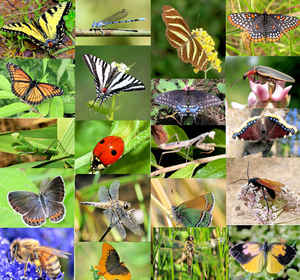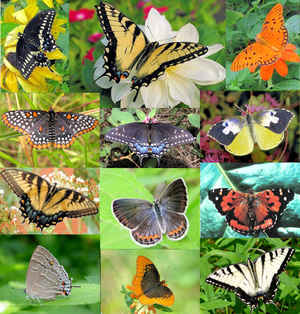
Georgia Symbols
Georgia State Butterfly
Tiger Swallowtail Butterfly

(Papilio glaucus)
Adopted in 1988.
The tiger swallowtail, (Papilio glaucus.) It was proclaimed the Georgia state butterfly in 1988 and is one of Georgia's most beautiful species of lepidoptera. This magnificent butterfly has large yellow wings edged and striped with black. The resolution designating a state butterfly was inspired by Mrs. Deen Day Smith, president of The Garden Club of Georgia, Inc., who donated funds to build the Day Butterfly Center at Callaway Gardens.
Georgia State Butterfly
Tiger Swallowtail Butterfly

The eastern tiger swallowtail, Papilio glaucus, one of the most common and widely distributed swallowtail butterflies in the eastern United States, has a wingspan that can reach 5 inches. The males' bright yellow wings have four black bands on the front wings, and a long black tail on each hind wing, and are easily identified. The first rendering of this species was of an adult male, drawn in 1587 by John White, commander of Sir Walter Raleigh's third expedition to North America. Some females, particularly those in the North, are black, with some blue interlaced with black bands on the hind wings. These females superficially resemble the poisonous blue pipevine swallowtail, Battus philenor.
Characteristics of the Tiger Swallowtail Butterfly
Color
P. glaucus has a black body with yellow stripes running laterally along both sides. The upper and lower wings are yellow accented with black bands (resembling tiger stripes). At the edges of all four wings are distinct black bands with yellow markings. The two lower wings have blue and orange spots near the tails (Klots,1979, 175).
Size
The Tiger Swallowtail is on average 4.0-5.0 inches in width, (Klots, 1979, 175) and 3.5-4.5 inches in height.
Food
The caterpillar feeds on trees: Wild Cherry, Tulip Tree, Birch, Poplar, and Ash (Klots, 1979, 175).
Life Cycle
- Two flights generally occur in the north, and three or four flights take place as far south as Florida.
- Male swallowtails fly at treetop level and descend to mate with lower-flying females.
- Females lay single, globular greenish-yellow eggs on the surface of leaves, and the young larvae that result are dark and resemble bird droppings.
- The two-inch-long mature larva or caterpillar is bright green and swollen in front, with false black and orange eyespots. These larvae spin a silk "mat" on the leaf, which curls the edges of the leaf somewhat.
- Larvae feed until they are full-grown, then develop into a dark brown or greenish brown caterpillar and descend the trunk of the tree and pupate on the ground, creating a dark stick-like chrysalis in which they overwinter.
- The pupa is light brown with a dark brown or black lateral stripe and dark brown dorsal band.
Habitat
The tiger swallowtail is widely distributed from New England west through the southern Great Lakes area (along Merriam's "transition life zone") through most of the Great Plains states and south to Texas and Florida. In the transition zone, the eastern tiger swallowtail is sympatric with the closely related Canadian tiger swallowtail, Papilio canadensis (until recently, considered a subspecies of P. glaucus).
Georgia Senate Bill No. 449
The tiger swallowtail butterfly became the official Georgia state butterfly when Governor Joe Frank Harris signed Senate Bill No. 449 on April 4, 1988.
S.B. 449
AN ACT
To amend Article 3 of Chapter 3 of Title 50 of the Official Code of Georgia Annotated, relating to other state symbols, so as to designate the tiger
swallowtail as the official state butterfly; to provide for related matters; to repeal conflicting laws; and for other purposes.
WHEREAS, butterflies in their resplendent beauty have fascinated children and adults for ages; and
WHEREAS, the Greeks believed that the butterfly emerging from the chrysalis represented man's metamorphosis from the mortal to the eternal; and
WHEREAS, Mrs. Deen Day Smith, the current President of The Garden Club of Georgia, Inc., was inspired by that same metaphor to donate funds in memory
of the late Cecil B. Day to build a butterfly center at Callaway Gardens; and
WHEREAS, the Day Butterfly Center which is scheduled to open the latter part of 1988 will stress the importance of conservation of the land and its
plants and animals for the enjoyment of present and future generations; and
WHEREAS, the tiger swallowtail is a beautiful example of the butterfly which is native to the State of Georgia; and
WHEREAS, it is only fitting and proper that the tiger swallowtail be designated as the official state butterfly.
NOW, THEREFORE, BE IT ENACTED BY THE GENERAL ASSEMBLY OF GEORGIA:
Section 1. Article 3 of Chapter 3 of Title 50 of the Official Code of Georgia Annotated, relating to other state symbols, is amended by adding a new
Code Section 50-3-62 at the end thereof to read as follows:
"50-3-62. The tiger swallowtail is designated as the official Georgia state butterfly."
Section 2. All laws and parts of laws in conflict with this Act are repealed.
Georgia Law
The law designating the tiger swallowtail as the official Georgia state butterfly is found in the Code of Georgia, Title 50, Chapter 3, Article 3, Section 50-3-62.
TITLE 50. STATE GOVERNMENT
CHAPTER 3. STATE FLAG, SEAL, AND OTHER SYMBOLS
ARTICLE 3. OTHER STATE SYMBOLS
O.C.G.A. § 50-3-62 (2008)
§ 50-3-62. Official butterfly
The tiger swallowtail is designated as the official Georgia state butterfly.
HISTORY:Code 1981, § 50-3-62, enacted by Ga. L. 1988, p. 853, ? 1.
Taxonomic Hierarchy: Eastern Tiger Swallowtail
Kingdom: Animalia (Animals)
Phylum: Arthropoda (Arthropods)
Subphylum: Hexapoda (Hexapods)
Class: Insecta (Insects)
Order: Lepidoptera (Butterflies and Moths)
Superfamily: Papilionoidea (Butterflies and Skippers)
Family: Papilionidae (Swallowtails, Parnassians)
Subfamily: Papilioninae
Tribe: Papilionini (Fluted Swallowtails)
Genus: Papilio
Species; glaucus (Eastern Tiger Swallowtail)
Butterflies, and Bugs







